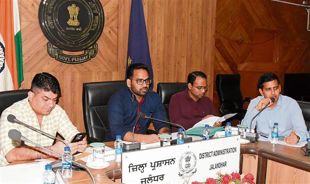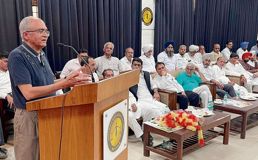
A skeleton found at the excavation site in Hisar district recently. File photos
Deepender Deswal
Hisar, April 30
To establish whether modern people living in Rakhigarhi village and those who lived about 5000 years back in the area shared the same genetics, Birbal Sahni Institute of Palaeosciences (BSIP), Lucknow, has taken samples of residents of the village to compare their DNA with the DNA extracts of skeletons recovered at the cemetery of the Harappan site located at the village.

Examination process on
We are in the process of analysing and examining the samples. It will take three to four months to come out with the results of the comparison of the DNA samples of the modern people and those who lived here during the Harappan era. Dr Neeraj Rai, a senior scientist
BSIP scientists took saliva and stool samples of 12 natives of the village recently. The samples will be examined in relation with the DNA results of a male skeleton, which was recovered at the site by the Archaeological Survey of India (ASI), sources said.
A senior scientist, Dr Neeraj Rai, confirmed to The Tribune today that they had collected the samples from the village. “We are in the process of analysing and examining them. It will take three to four months to come out with the results of the comparison of the DNA samples of the modern people and those who lived here during the Harappan era,” he said.
Harappan era mounds at Rakhigarhi has drawn the attention of historians and archaeologists the world over as this was tipped as one of the biggest towns of the Indus Valley Civilisation. The ASI had collected samples of a skeleton recovered at the site during excavation two years ago.
Dinesh Sheoran, a former sarpanch, who has a keen interest in archaeology, said the villagers also wanted to know about their historical background. “They were not interested in the activities of archaeologists till about a decade ago. But now, they are well aware of the findings of archaeologists. We have a deep interest in the past, which dates back to the early Harappan era about 8000 years ago,” he said.
Deccan College, Pune, had also carried out path-breaking excavation work at the site in 2015-16, when it discovered skeletons at the burial site at mound No. 7. The then Vice-Chancellor of the college, Prof Vasant Shinde, has also released studies regarding the DNA analysis of the skeletons and claimed that people of modern times living in different parts of South Asia, ranging from Andaman and Nicobar to Ladakh-Kashmir, and from Bengal to Afghanistan, shared the same ancestry. He said we all were Harappan descendants and debunked the migration theory.
Join Whatsapp Channel of The Tribune for latest updates.




























